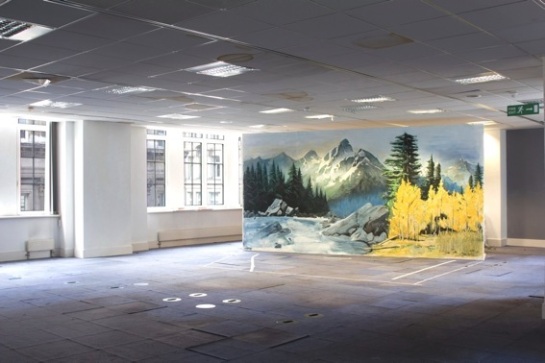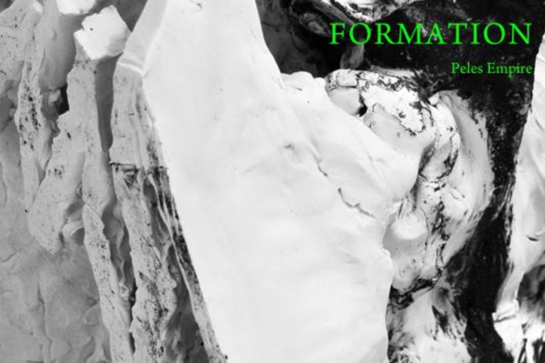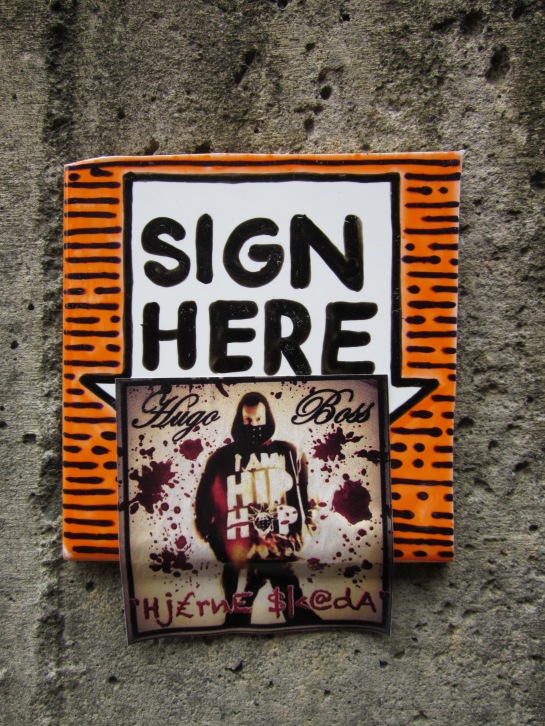This month the WW Gallery has been divided by two artists with two very different agendas, but equally wicked senses of humour. Siobhan Barr’s Hello Friend is an exposé of the dark and downright hilarious corners of the internet. While Jay Rechsteiner’s Jay Gun, The Most Dangerous Man on the Planet is a game which parodies boyish gun-obsessions, where home-made rifles can be pulled from the walls and tested, and a BB Gun offers target practice.  Jotta asked me to do an interview with Siobhan because of their particular interest in artists responding to evolving technologies. Here’s the Interview in full:
Jotta asked me to do an interview with Siobhan because of their particular interest in artists responding to evolving technologies. Here’s the Interview in full:
Siobhan Barr’s ‘Hello Friend’ at the WW Gallery is a sharp, and wickedly funny survey of the obscure, murky corners of the internet. The social paranoias of humanity, as collected and regurgitated by Google, are merely a prelude to gangs of mothers with their own catalogue of Mumsnet acronyms, and forums for homemade sex toys. Barr’s interest in technology and the internet have turned her into an undercover investigator – a tech geek and a chardonnay sipping mother are just some of her multiple personae – but above all she is an astute observer of society’s relationship to evolving technologies. If at times she is swept into the all-consuming obsession which constant data streams and live life feeds encourage, she also remains a subversively comic commentator. Her extraction of language from the internet, from the fans and fetishists who thought it up, leaves it bizarre, poetic, puzzlingly: a brilliant joke.
When did you begin to take inspiration from the internet in your work?
My current show “Hello Friend” is the first body of work that I’ve presented which is intentionally and exclusively inspired by our relationship with the internet; previously my work focused on other elements of popular culture, and modern telecommunications. However I can pinpoint my fascination with technology and the accumulation of source material for my work to 2009. I saw a show at Cell Project Space called “Trying to Cope with Things That Aren’t Human”, and a related panel discussion: this had a profound effect on me, and triggered an interest in how people turn to the invented world as we struggle to relate to the natural world. I also experienced a fairly monumental shift in my lifestyle and environment that year: I had to cease working due to ill health, became increasingly reclusive and moved into a house without a TV aerial or standard phone line which forced an upgrade from a lousy dial-up connection to super speedy cable broadband. All these factors, unsurprisingly, led to a fairly instant addiction and dependence on the internet as face-to-face time became displaced by time online, and so my work gradually became increasingly concerned with these themes.
What series of works are on show at the Hello Friend! exhibition at WW Gallery?
There are 10 works and series of works included within the show, including an illuminated “studio audience” style sign flashing the words “MULTIPLE LOL”, inflatable Stepford Wives “Mumsnet” dolls holding Cath Kidston bunting spelling out popular acronyms used on their forum, a short video (my first actually), and a lot of text pieces, mostly in a digital format with an element of optional interactivity using a QR code and smartphone.
Although I consider the works to be varied in that they are selected snapshots of the projects I have been developing, most of the work falls into three categories, all of which can be associated with the show’s title “Hello Friend”: forums, sales (which, in a broader sense, also includes spamming) – and themes of loneliness. ‘Loneliness’ is a kind of umbrella category but it also specifically relates to “Autocomplete”, whereby I’ve put a 3 year log book to use and have displayed selected popular Google searches. In my opinion, autocomplete algorithms are the ultimate survey into what people anonymously ask their friend, “Google”, and some of the results are depressing, some hilarious, or very often, both.
One of your interests is in the impact modern technology has had on our evolving language. You use a lot of language from the internet in your work, what is it that’s so appealing about this?
I have always said that I predominantly work with text because I perceive it to be a confident and no-frills approach, as well as being more accessible to people who may feel alienated by contemporary art. But like any text artist, I’m also interested in linguistics, and the role language plays in our relation to the world we live in. Therefore it goes without saying that I am fascinated by our evolving language, and the trends that set these changes in motion.
In 2010 I made “T9 is shiv” which, as the title suggests, was based upon “textonyms” – words produced by the same combination of key taps using the now out-dated numerical keypad of mobile phones, resulting in nonsensical imperatives. Shortly after this I started integrating language and acronyms predominantly used in internet chat speak into my work, and particularly enjoyed placing them within more high-brow and traditional contexts, such as a sacred illuminated manuscript. By doing this, I suppose I was trying to emulate how I feel when I see these bizarre acronyms such as “lol” or “pmsl” crop up at the end of friends’ text messages, or during an internet chat session; it still feels jarring and alien to me, and I suppose if I’m being honest I am a bit snobby about them. I both like and loathe the fact I feel so uncool and am forever having to decipher their meanings. It’s like a puzzle and I recreate that puzzlement when I present them to my audience.
I’m pleased the word “lolz” got added to the Oxford English Dictionary recently, and not just because I’m a Scrabble fan and “z” is worth 10 points. I’d previously found my definition in an online forum, which became my illuminated sign:
“lolz…seriously, u don’t know what it is? are you ninety???? it’s multiple lol!!!!”
Some of your works become strangely poetic, what are the most bizarre or funny snippets you’ve found and put to use?
On my quest to find non-sexualised inflatable dolls (come see the show if you don’t believe they exist!) I spent an afternoon in Soho. A gregarious bookshop keeper led me downstairs, past a peep show, into a non-bookshop, and showed me every type of doll he sold. My eyes lit up when I glanced at the packaging for “Fatty Patty the Jumbo Love Doll”, not because of the imagery or a penchant for seedy inflatables, but because of the description. It was just a string of crude “Yo Mama’s so fat” jokes, spliced together with little punctuation. When home again I found it online, lifted the text, changed the format into a poem on archival paper, and that’s the “Fatty Patty” on exhibition now.
Where do the words from the pin-board ads come from?
The words from the pin-board ads are taken from Asian B2B trading sites such Alibaba.com, which I have personal experience with. They are actual descriptions, presumably produced by some whacky non-human translation software; I’ve merely selected them for their comedic and cryptic (and now you mention it, poetic) values. Each ad features a description and a QR code which links to a website I built with a “Buy It Now” button relevant to each ad, no imagery. If you so wished to take a punt, (items start from as little as £3), I’ll send you the mystery item. I thought it would be a fun piece to interact with, in a Secret Santa sort of way. It also mirrors the buying experience with these sites, as although there are many successful and trustworthy sellers, inevitably due to a lack of regulation on photographs and descriptions used in listings, personal experience has demonstrated to me that it’s a bit of a gamble and you’re never 100% sure that you’ll get the advertised item you paid for. So a bit like the QR codes, they mirror the act of opening unsolicited junk email.
Siobhan Barr’s Hello Friend and Jay Rechsteiner’s Jay Gun, The Most Dangerous Man on the Planet will be on at the WW Gallery until 2nd March.








